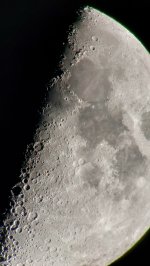BoldenEagle
Well-known member

Couple of days ago I took my Kowa TSN 883 spotting scope to see the Moon as it was very high on the night sky. Seeing was very good so I installed APM 3.5mm XWA 1.25" astro eyepiece to have about 145x magnification and the view was very crisp, lots of detail to be seen. APM 3.5 XWA has very limited eye relief so I took my glasses off and I was very surprised how sharp I could see; normally my bad astigmatism prevents me to see any small details without glasses. With my glasses on, I could still see sharper but the difference was small. With more "normal"spotting scope (25-60x) magnifications viewing with my glassen off is out of the question as everything is totally blurry. I suppose that with a very small exit pupil, with an 88mm aperture about 0.6mm, I'm using such small area in the center of my eye's lens that the astigmatism has not very strong effect yet. Or is there some other explanation for this?
Regards, Juhani
Regards, Juhani







